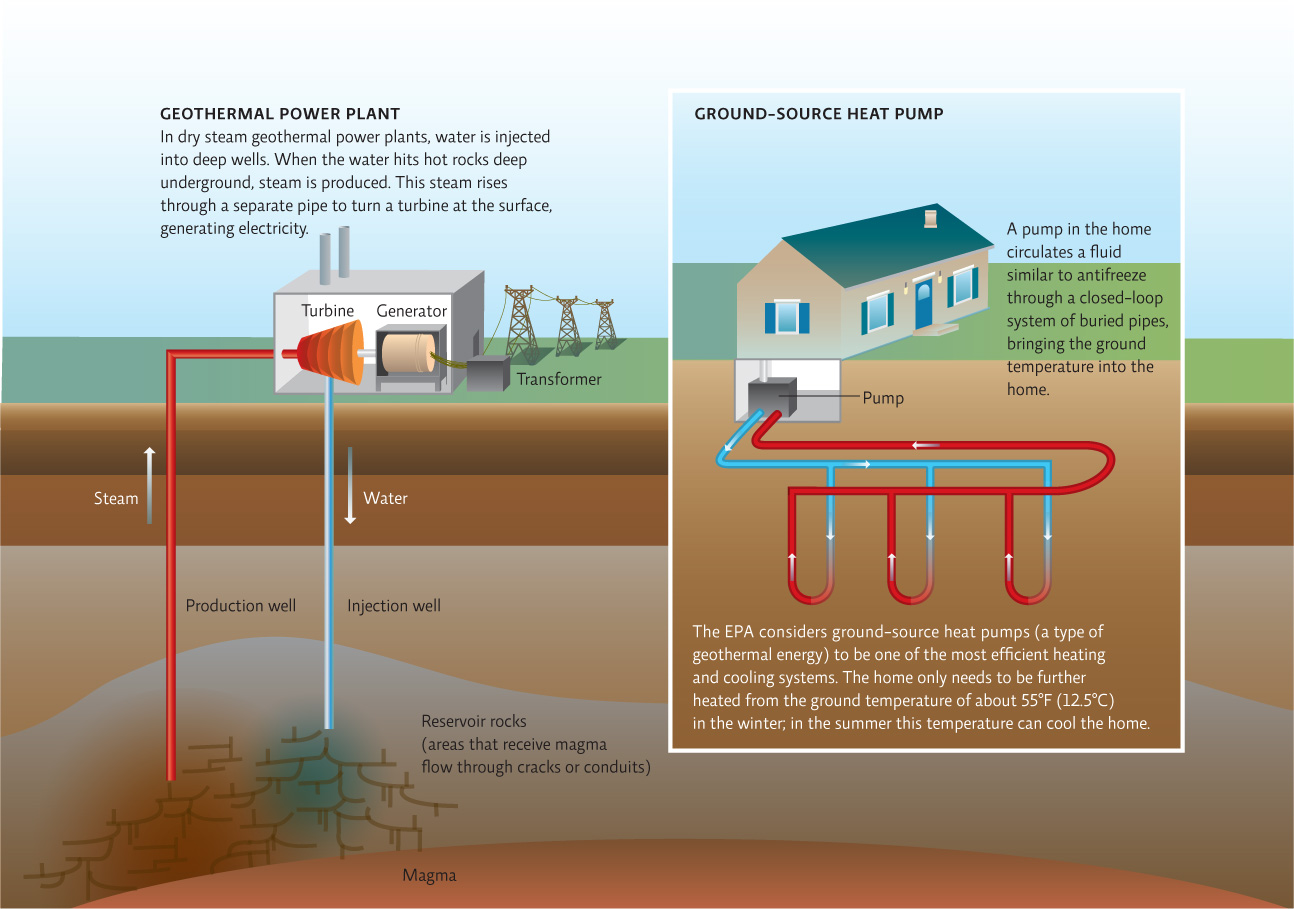Energy that causes volcanos to erupt and warms hot springs can also heat our homes.
KEY CONCEPT 23.5
Geothermal energy can be captured on a small scale to lower home heating and cooling costs or on a large scale to produce electricity or heat.
Unlike Samsø, some communities are fortunate enough to be located near sources of geothermal energy. A tremendous amount of heat is produced deep in Earth from radioactive decay of isotopes; temperature increases with depth, and Earth’s core may be 9,000°F (5,000°C). It is the same heat that bubbles hot springs and causes geysers to erupt from the ground at Yellowstone National Park in Wyoming. Within the past century, technological advances have enabled us to tap into these vast resources for heat and electricity. “There has been a huge surge in the development of geothermal resources,” says Wilfred Elders, co-chief scientist of an ambitious geothermal project known as the Iceland Deep Drilling Project (IDDP). “It is one of the most viable and economically attractive sources of renewable energy.”
geothermal energy
Heat stored underground, contained in either rocks or fluids.
A wide variety of geothermal systems are currently in use. Geothermal heat pumps (also called ground-source heat pumps) are used in more than half a million homes around the world—not to generate electricity but to reduce our use of it. If you have ever been in a cave, you have probably been struck by the cool, constant temperatures there—always around 55°F (12.5°C), whether it’s freezing outside or in the middle of a heat wave. No matter what the temperature above, at modest depths underground, the temperature remains a constant 55°F. Engineers bury fluid-filled pipes, and the fluid takes on that ground temperature. The fluid is then pumped into the home, where its temperature is transferred to air ducts and circulated through the home, essentially providing residents with year-round 55°F temperatures. In the winter, the home only needs to be warmed up from 55°F, rather than the outside colder temperatures, and in the summer, this system provides natural cooling. Such pumps are fairly expensive to install ($20,000 to $25,000 on average) but result in lower monthly energy bills than conventional heating and cooling systems. Areas with more extreme climates save enough money in monthly bills to offset the cost of installation—a metric known as payback time—in as little as 5 years.
geothermal heat pump
A system that transfers the steady 55°F (12.5°C) underground temperature to a building to help heat or cool it.
payback time
The amount of time it takes to save enough money in operation costs to pay for equipment.
On the other end of the spectrum are geothermal power plants. Generators above geothermal wells use steam released from hydrothermal reservoirs (hot springs) to spin turbines and produce electricity. Hydrothermal reservoirs are areas in Earth’s crust that hold heat energy in the form of water, either as steam or liquid. Geysers in northern California power the world’s largest geothermal electrical system, generating more than 1,000 MW of energy—enough for a city as large as San Francisco.
geothermal power plants
Power plants that use the heat of hydrothermal reservoirs to produce steam and turn turbines to generate electricity.
Because sustainable energy sources have strengths and weaknesses, no single source will likely meet the needs of any particular community, and certainly not those of the entire world.
Geothermal power plants are reliable and efficient, but their potential is entirely dependent on location. Because drilling is expensive, only sites with enough accessible heat to generate significant electricity are considered for development. These tend to be hot zones, locations like Iceland and the western United States, where the tectonic plates in Earth’s crust pull away from or rub against each other, allowing the hot magma to flow upward through cracks in the rock to reach areas closer to the surface. The ambitious IDDP is attempting to drill into a high-temperature geothermal system (the Krafla volcano, in this case), penetrate twice as deep as conventional geothermal wells (which are usually less than 3,000 meters [10,000 feet] deep), and reach supercritical fluids, substances with temperatures above 700°F (350°C) that are confined by such intense pressure that they exist in a limbo state between liquid and gas. The resulting superheated steam could generate 10 times the electricity of most geothermal wells.
This type of renewable energy is becoming more popular. Between 2005 and 2010, use of geothermal power worldwide increased by 20%, according to the International Geothermal Association, and it is currently growing at an annual rate of 4% to 5%. As of 2013, geothermal power plants were annually producing 30,000 MW of geothermal power online, with another 12,000 MW of projects under construction or proposed. INFOGRAPHIC 23.4
The high temperatures found underground in some regions can be tapped to generate electricity. Geothermal heat can also be piped directly to communities to provide heat or hot water. Geothermal energy can also be tapped using ground-source heat pumps, reducing the cost to heat and cool individual buildings.


The two geothermal technologies are quite different. Which one actually prouduces electricity, and which one helps you conserve energy?
The geothermal power plant uses the heat from the Earth in a thermoelectric power plant to produce electricity. The ground-source heat pump raises the temperature of your home in the winter so that you are only heating your home up from a starting place of 55°F, rather than the outside temperature. In the summer, the cooler temperatures found underground are delivered to the home to cool it.
Harnessing such a powerful heat source can be difficult, however. In early 2007, an earthquake of magnitude 3.4 on the Richter scale shook the town of Basel, Switzerland. The quake was attributed to a geothermal mining project in the area, and the project was halted. The Iceland drilling project also experienced serious problems when the drill repeatedly got stuck 2 kilometers (1.3 miles) deep into a volcanic crater, leading to months of jammed drill bits and broken pipes.